Comments / Questions (299)
![]() Kathleen wrote:
Kathleen wrote:
Thank you for your response! It makes perfect sense now. Looking forward to seeing the finished result. It's a beautiful pattern. Thank you.
03.10.2013 - 21:11
![]() Catrien Daems wrote:
Catrien Daems wrote:
Bedankt voor de uitleg. sorry dat ik wat ongeduldig was, maar als je begint met iets te breien wil je graag z.s.m. resultaat, maar ik kan nu verder en dat lukt prima. nogmaals dank. vr.gr. catrien
03.10.2013 - 19:48
![]() Kathleen wrote:
Kathleen wrote:
M2 and M3 are a little confusing. The diagram shows 4 rows of pattern but then nothing on the right and left sides of the centre section. Does this mean that rows 1 to 4 are the pattern and to repeat from cables at the bottom til work measures 23cm?
03.10.2013 - 02:02DROPS Design answered:
Dear Kathleen, repeat the diagrams as they are shown, ie both cables won't be done on same rows: 1st and 4th cable are worked every 4th row, and the middle ones (2nd and 3rd cables) are worked every 6th row. Happy knitting!
03.10.2013 - 10:22
![]() Catrien Daems wrote:
Catrien Daems wrote:
Misschien is mijn vraag niet goed aangekomen, maar ik heb nog geen antwoord gehad. de vraag is door anderen vaker gesteld, vlgs mij, maar de vertaling is bij mij niet zo goed dat ik de antwoorden snap. m.vr.gr. catrien
30.09.2013 - 11:59DROPS Design answered:
Hoi Catrien. Je vraag is beantwoord. Vanwege drukte kon ik helaas niet eerder reageren. Veel breiplezier verder.
02.10.2013 - 16:03
![]() Catrien Daems wrote:
Catrien Daems wrote:
Wat betekenen de 2 legen rijen van 12 steken in patroon m2 en m3.en is m1 dubbele (4 pennen)of enkele (2) gerstekorrel? m.vr.gr. catrien
23.09.2013 - 12:36DROPS Design answered:
Hoi Catrien. Het betekent dat je 5 nld breit tussen de grote kabels in het midden van M.2/M.3 en maar 3 nld tussen de kleine kabels. M.1 is dubbele gerstekorrel.
02.10.2013 - 16:02
![]() Connie Lumsden wrote:
Connie Lumsden wrote:
I want to say I really love this pattern. Ive not seen one quite like it I have done sweaters, socks and mittens. however I am finding this pattern quite difficult to read. when it tells me to continue in m1 does this mean knit 1 purl 1 for 2 rows then purl 1 knit 1 for 2 rows. I am taking the white blocks as k and the x box as purl is this right? I really appreciate any help with this I would dearly love to knit this pattern.
01.09.2013 - 15:12DROPS Design answered:
Dear Mrs Lumsden, you are correct, M.1 is worked this way, seen from RS (white block are K from RS and P from WS, x-blocks are P from RS and K from RS). Happy knitting!
02.09.2013 - 10:34
![]() Siegrid Hering wrote:
Siegrid Hering wrote:
Mit Kapuze ist das 1 Risiko .Hab es bei meinen Kids gemerkt .Wir haben die Kapuze abgetrennt deshalb.
29.08.2013 - 14:38
![]() Viktoria wrote:
Viktoria wrote:
Hei. Det er litt irriterende når jeg leser igjennom oppskriften igjen når jeg er halvveis. Jeg leser før jeg begynner, og setter igang med å strikke. Men nå leser jeg igjennom spørsmålene, og oppskriften finner jeg ut jeg har gjort mange feil. ikke for det, det blir fint, får jeg høre av andre. men jeg sliter litt med den felling-av-flette. jeg har 51 cm, er på vrangsiden, men skjønner ikke hvilken flette, og hvordan. de to midterste og de to på siden av fletten? Viktoria.
09.08.2013 - 03:26DROPS Design answered:
Hei Viktoria. Du har en flette der gaar langs midt foran. Paa höjre forstk strikker du M.3 - du har da 10 vrang midt for, förste flette i M.3, 4 vr. Du feller nu 1 m i de 10 vr, 1 m over förste flette og 1 over de 4 vr (du feller ved at strikke sammen). I naeste p saetter du de förste 6 m paa en traad og lukker af som beskrevet.
23.08.2013 - 10:53
![]() Dona wrote:
Dona wrote:
Please disregard my earlier question. Figured it out.
08.08.2013 - 00:49
![]() Dona wrote:
Dona wrote:
Please disregard my earlier question. Figured it out.
08.08.2013 - 00:49
Snuggly Bunny#snugglybunnybuntingbag |
|||||||||||||||||||
 |
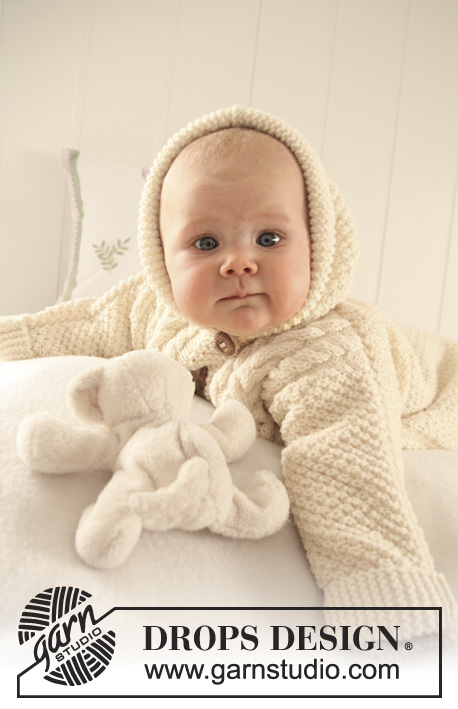 |
||||||||||||||||||
Knitted bunting bag in moss st with textured pattern and cables in DROPS Merino Extra Fine
DROPS Baby 19-10 |
|||||||||||||||||||
|
BUNTING BAG: GARTER ST (back and forth on needle): K all rows. PATTERN: See diagram M.1 to M.3. Diagrams show the pattern from RS. First row in M.2 and M.3 = RS. HOLE FOR SEAT BELT IN CAR SEAT: You can make a hole on front and back piece for car seat belt. Make the hole when piece measures approx 16-20-23 (28-33) cm (or required measurements) by casting off the middle 10 sts on needle. On next row cast on 10 new sts over cast off sts and continue as before. BUTTONHOLES: Make buttonholes on right front band. 1 buttonhole = K tog 2nd and 3rd st from mid front and make 1 YO. Make buttonholes when piece measures: Size 1/3 months: 25, 30, 35, 40, 45 and 50 cm. Size 6/9 months: 28, 34, 41, 47, 54 and 60 cm. Size 12/18 months: 30, 38, 46, 54, 62 and 70 cm. Size 2 years: 37, 44, 51, 58, 65, 72 and 79 cm. Size 3/4 years: 40, 48, 57, 65, 74, 82 and 91 cm. -------------------------------------------------------- -------------------------------------------------------- BUNTING BAG: The bag is worked in 2 parts from bottom edge and up and sewn tog afterwards. Work each part back and forth on circular needle in order to fit in all sts. NOTE: If hole for seat belt is required – see above. BACK PIECE: Cast on 68-74-82 (86-94) sts (includes 1 edge st each side) on circular needle size 4 mm with Merino Extra Fine. Work GARTER ST - see above – for 4-4-4 (5-5) cm – adjust to a row from WS. P 1 row from WS and continue in M.1 with 1 edge st in garter st each side (beg with K1 after edge st). When piece measures 44-53-62 (71-82) cm cast on new sts for sleeves each side. Cast on at the end of every row as follows: 4 sts 2-2-3 (3-3) times, 8 sts 1-1-1 (1-3) times, 10 sts 1-1-1 (2-1) times and 12-14-15 (15-16) sts 1 time = 144-154-172 (196-218) sts on needle – NOTE: incorporate inc sts in M.1 as you go along - when all sts have been cast on continue M.1, but with 10 sts each side in garter st (= bottom edge of sleeves). When piece measures 54-64-74 (84-96) cm cast off the middle 16-18-22 (24-24) sts for neck and complete each shoulder/sleeve separately. Cast off 1 st on neckline on next row = 63-67-74 (85-96) sts left on needle (= shoulder + sleeve). Cast off when piece measures 56-66-76 (86-98) cm. Repeat on the other side. FRONT PIECE: Cast on 68-74-82 (86-94) sts and work garter st for 2-2-2 (2.5-2.5) cm, then work next row as follows from RS: K 12-13-14 (14-16) sts, * K2 tog, 1 YO, K 12-13-15 (12-13) sts *, repeat from *-* a total of 3-3-3 (4-4) times, K2 tog, 1 YO and finish with K 12-14-15 (14-16) sts (= 4-4-4 (5-5) buttonholes). Continue in garter st until edge measures 4-4-4 (5-5) cm - adjust to a row from WS. P 1 row from WS, AT THE SAME TIME inc 22 sts evenly = 90-96-104 (108-116) sts. Work next rows as follows from RS: 1 edge st, M.1 on the first 5-8-12 (14-18) sts (beg with K1 at the side to match pattern at the side to back piece), M.2 (= 32 sts), P 14 sts, M.3 (= 32 sts), M.1 on the next 5-8-12 (14-18) sts (adjust so M.1 finishes with P1 at the side before edge st to match pattern to back piece) and finish with 1 edge st. Continue in pattern like this with M.1, M.2 and M.3 and 14 sts in reverse stocking st mid front. When piece measures 23-25-28 (33-37) cm slip the first 42-45-49 (51-55) sts on a stitch holder = 48-51-55 (57-61) sts left on needle. RIGHT FRONT PIECE: = 48-51-55 (57-61) sts. Continue in pattern as before, but work the 6 sts towards mid front in garter st for front band - REMEMBER BUTTONHOLES - see above! When piece measures 44-53-62 (71-82) cm cast on new sts for sleeve at the end of every row towards the side as described for back piece = 86-91-100 (112-123) sts. When all sts have been cast on continue in pattern as before, but work the 10 sts on sleeve edge in garter st. When 1 row remain before piece measures 51-61-71 (80-92) cm – adjust so this row is from WS - dec 4 sts on the cable towards mid front (i.e. dec 2 sts over cable and 1 st each side of cable). On next row from RS slip 6-7-8 (9-9) sts towards mid front on a stitch holder for neck. Cast off to shape the neckline at the beg of every row from mid front: 2 sts 2 times and 1 st 2-2-3 (3-3) times = 70-74-81 (92-103) sts left on needle (= shoulder + sleeve). Continue in pattern as before. When 1 row remain before piece measures 56-66-76 (86-98) cm dec 7 sts evenly over sts in cables in M.3 = 63-67-74 (85-96) sts. On next row cast off all sts. LEFT FRONT PIECE: Slip sts from stitch holder back on needle and pick up 6 sts behind the 6 garter sts on right front band = 48-51-55 (57-61) sts. Continue as described for right front piece but mirrored – NOTE: do not make buttonholes on front band. ASSEMBLY: Sew shoulder/over arm seams. Sew seam under sleeves and down along the side inside 1 edge st. Fold 5 cm on each sleeve edge towards RS and fasten with a couple of sts. Sew 4-4-4 (5-5) buttons at bottom of bunting bag and sew remaining buttons on left front band. HOOD: Pick up from RS approx 58 to 78 sts round neck (includes sts from stitch holders at front) on circular needle size 4 mm with Merino Extra Fine. K 1 row from WS, then K 1 row from RS, AT THE SAME TIME inc evenly to 85-89-93 (97-101) sts. Continue in M.1 with 6 garter sts each side - AT THE SAME TIME cast on 6 new sts at the end of the next 2 rows for folding edge = 97-101-105 (109-113) sts – work these sts in garter st. Continue in M.1 with 12 garter sts each side until hood measures 21-23-25 (27-28) cm and cast off. Fold hood double and sew tog at the top. Fold 6 garter sts round opening of hood towards RS and fasten to neckline with neat sts. |
|||||||||||||||||||
Diagram explanations |
|||||||||||||||||||
|
|||||||||||||||||||
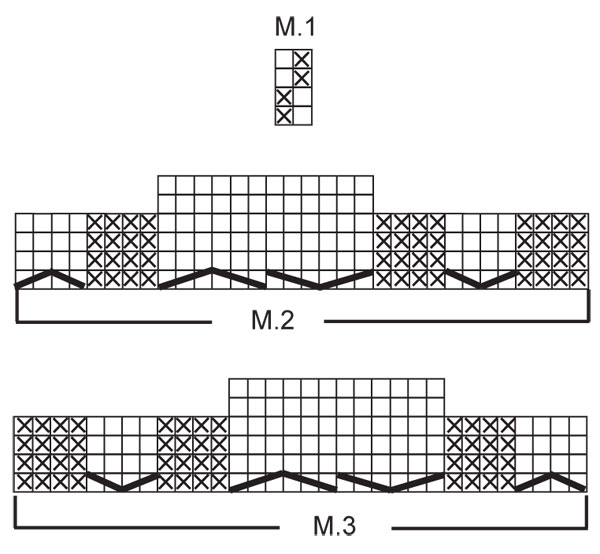 |
|||||||||||||||||||
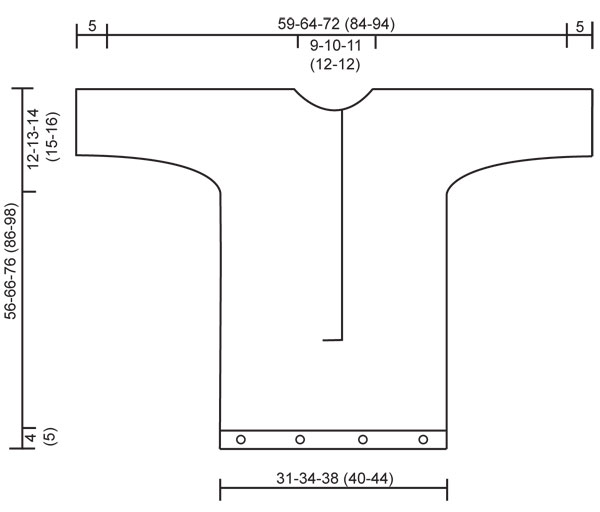 |
|||||||||||||||||||
Have you finished this pattern?Tag your pictures with #dropspattern #snugglybunnybuntingbag or submit them to the #dropsfan gallery. Do you need help with this pattern?You'll find 19 tutorial videos, a Comments/Questions area and more by visiting the pattern on garnstudio.com. © 1982-2025 DROPS Design A/S. We reserve all rights. This document, including all its sub-sections, has copyrights. Read more about what you can do with our patterns at the bottom of each pattern on our site. |
|||||||||||||||||||








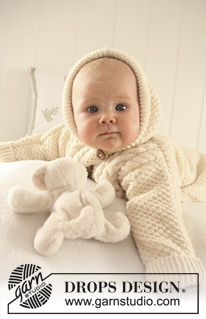





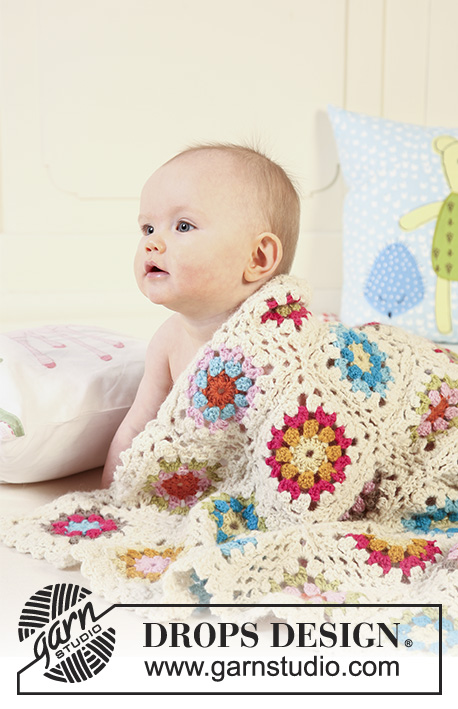















































Post a comment to pattern DROPS Baby 19-10
We would love to hear what you have to say about this pattern!
If you want to leave a question, please make sure you select the correct category in the form below, to speed up the answering process. Required fields are marked *.